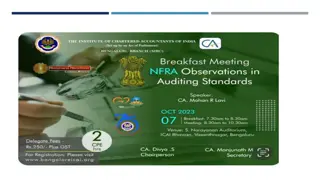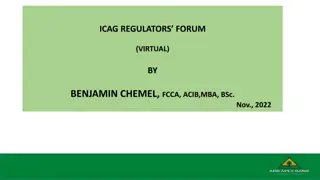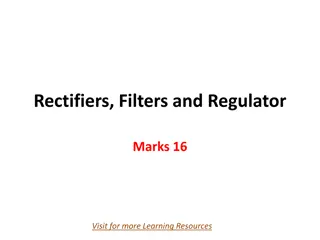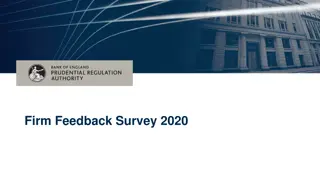
Financial Regulators: Supervision and Regulation in the Market
Learn about the role and functions of financial regulators like the IRDA in ensuring fair and efficient markets, preventing malpractices, and promoting financial stability. Explore their history, structure, and key objectives in regulating the insurance industry.
Download Presentation

Please find below an Image/Link to download the presentation.
The content on the website is provided AS IS for your information and personal use only. It may not be sold, licensed, or shared on other websites without obtaining consent from the author. If you encounter any issues during the download, it is possible that the publisher has removed the file from their server.
You are allowed to download the files provided on this website for personal or commercial use, subject to the condition that they are used lawfully. All files are the property of their respective owners.
The content on the website is provided AS IS for your information and personal use only. It may not be sold, licensed, or shared on other websites without obtaining consent from the author.
E N D
Presentation Transcript
A financial regulator is a constituent of the financial system. Financial regulators supervise, monitor and regulate various constituents of the system. Their objective is to develop fair & efficient markets and ensure financial stability.
Making & enforcing regulations Preventing malpractices, manipulations & punishing misconducts Monitoring & protecting various constituents of the system Ensuring the competence of the constituents
RBI IRDA SEBI NHB PFRDA
Meaning Role & Functions History & Origin Structure & Hierarchy Departments
Following the recommendations of the Malhotra Committee report, in 1999, the Insurance Regulatory and Development Authority (IRDA) was constituted as an autonomous body to regulate and develop the insurance industry. The IRDA was incorporated as a statutory body in April, 2000. IRDA (Insurance Regulatory and Development Authority) is the national regulatory body for Insurance industry (both Life and Non-Life Insurance Companies) under the Government of India, situated at Hyderabad.
The key objective of the IRDA includes promotion of competition so as to enhance customer satisfaction thru increased consumer choice and lower premiums, while ensuring the financial security of the insurance market. The IRDA opened up the market in August 2000 with the invitation for application for registrations.
As per the section 4 of IRDA Act' 1999, Insurance Regulatory and Development Authority specify the composition of Authority The Authority is a ten member of : (a) (b) (c) ten member team consisting a Chairman; five whole-time members; four part-time members, (all appointed by the Government of India)
The whole time members shall hold office for 5yrs or until the age of 62 which ever is earlier. The chairman shall hold the office for 5 yrs until the age of 65 yrs whichever is earlier. The part time members will hold the office for not more than 5 yrs. The above said members are to be appointed by the central government from among the persons of ability and standing who have knowledge or experience in life insurance, general insurance, actuarial science, finance, economics, law, accountancy, administration or any other discipline which would, in the opinion of central government.
To take care of the policyholders interest. To open up the insurance sector for private sector. To ensure continued financial soundness and solvency. To regulate insurance and reinsurance companies. To eliminate dishonesty and unhealthy competitions. To supervise the activities of intermediaries in insurance sector. To amend the Insurance Act 1938 and LIC Act 1956 and General Business Nationalisation Act, 1972. 1. 2. 3. 4. 5. 6. 7.
Protection of the interests of the policy holders in matters concerning assigning of policy, nomination by policy holders, insurable interest, settlement of insurance claim, surrender value of policy and other terms and conditions of contracts of insurance; Settlement of disputes b/w insurers and intermediaries. Issuing certificate of registration, renew, modify, withdraw, suspend or cancel the same. Specifying the form and manner in which books of accounts are to be maintained by insurers and other insurance intermediaries. 1. 2. 3. 4.
Control and regulate rates, terms & conditions that may be offered by insurers in respect of General Insurance. Specifying qualifications, code of conduct and training for insurance intermediaries, agents, surveyors and loss assessors. Inspecting and investigating operations of insurance companies including audit of the insurers, intermediaries and other organisations connected with the insurance business. Regulating investment of funds by insurance companies, maintenance of margin of solvency. 5. 6. 7. 8.
9. Specifying the percentage of Rural or Social sector life insurance business and general insurance business which needs to be undertaken by the insurers. 10. IRDA promotes and regulates organisations connected with the insurance and the re - insurance business.
Departments Life Departments Objectives Regulating Life Insurance Objectives Functions It is primarily to monitor the practices of life insurers and review operational procedures, business/ services, data and for granting certain prior approval as required by the Act It is composed of various sub divisions Product Division : Deals with clearance of various products, issues circulars, guidelines and prepares regulations. Health including TPA s : Handles TPA related matters like registration, issuing licenses, approvals grievances Other Divisions Handle Intermediaries, agency Distributions, Inspection Surveyors Department Functions Non Life Regulating Non Life Insurance
Departments Investment Departments Objectives Regulation of Investments Objectives Functions Monitoring periodical returns, checking compliance of regulation of investment returns, issue circulars relating to investment matters. Monitor FDI, approve restructuring of M&A, IPO of insurance companies It looks into complaints from policyholders (Life and Non Life handled separately). It plays a facilitative role by taking up complaints with the respective insurers. Internal Accounts/Admin / HR/ IT/ Legal etc Functions Finance Operations of the Company Policyholders Interest Consumer Affairs Other Departments
SEBI was established as a non-statutory board in 1988 and in January 1992 it was made a Statutory body. The main objectives of SEBI are : Investor protection, so that there is a steady flow of savings into the Capital Market. Ensuring the fair practices by the issuers of securities, namely, companies so that they can raise resources at least cost. Promotion of efficient services by brokers, merchant bankers and other intermediaries so that they become competitive and professional. 1. 2. 3.
In 2002, SEBI is further empowered to do the following:- 1. To file complaints in courts and to notify its regulations without prior approval of government. 2. To regulate issue of capital and transfer of securities. 3. To impose monetary penalties on various intermediaries and other participants for a specified range of violations. 4. To issue direction to and to call for documents from all intermediaries.
The SEBI performs functions to meet its objectives. To meet the objectives, SEBI has three important functions. These are: i. Protective functions ii. Developmental functions iii. Regulatory functions.
These functions are performed by SEBI to protect the interest of investor and provide safety of investment: It Checks Price Rigging It Prohibits Insider trading SEBI prohibits fraudulent and Unfair Trade Practices SEBI undertakes steps to educate investors so that they are able to evaluate the securities of various companies and select the most profitable securities. 1. 2. 3. 4.
SEBI promotes fair practices and code of conduct in security market by taking following steps: (a) SEBI has issued guidelines to protect the interest of debenture-holders wherein companies cannot change terms in midterm. (b) SEBI is empowered to investigate cases of insider trading and has provisions for stiff fine and imprisonment. (c) SEBI has stopped the practice of making preferential allotment of shares unrelated to market prices. 5.
These functions are performed by the SEBI to promote and develop activities in stock exchange and increase the business in stock exchange. (i) SEBI promotes training of intermediaries of the securities market. (ii) SEBI tries to promote activities of stock exchange by adopting flexible and adoptable approach in following way: (a) SEBI has permitted internet trading through registered stock brokers. (b) SEBI has made underwriting optional to reduce the cost of issue. (c) Even initial public offer of primary market is permitted through stock exchange.
These functions are performed by SEBI to regulate the business in stock exchange. 1. SEBI has framed rules and regulations and a code of conduct to regulate the intermediaries such as merchant bankers, brokers, underwriters, etc. 2. These intermediaries have been brought under the regulatory purview and private placement has been made more restrictive.
3. SEBI registers and regulates the working of stock brokers, sub-brokers, share transfer agents, trustees, merchant bankers and all those who are associated with stock exchange in any manner. 4. SEBI registers and regulates the working of mutual funds etc. 5. SEBI regulates takeover of the companies. 6. SEBI conducts inquiries and audit of stock exchanges.






















